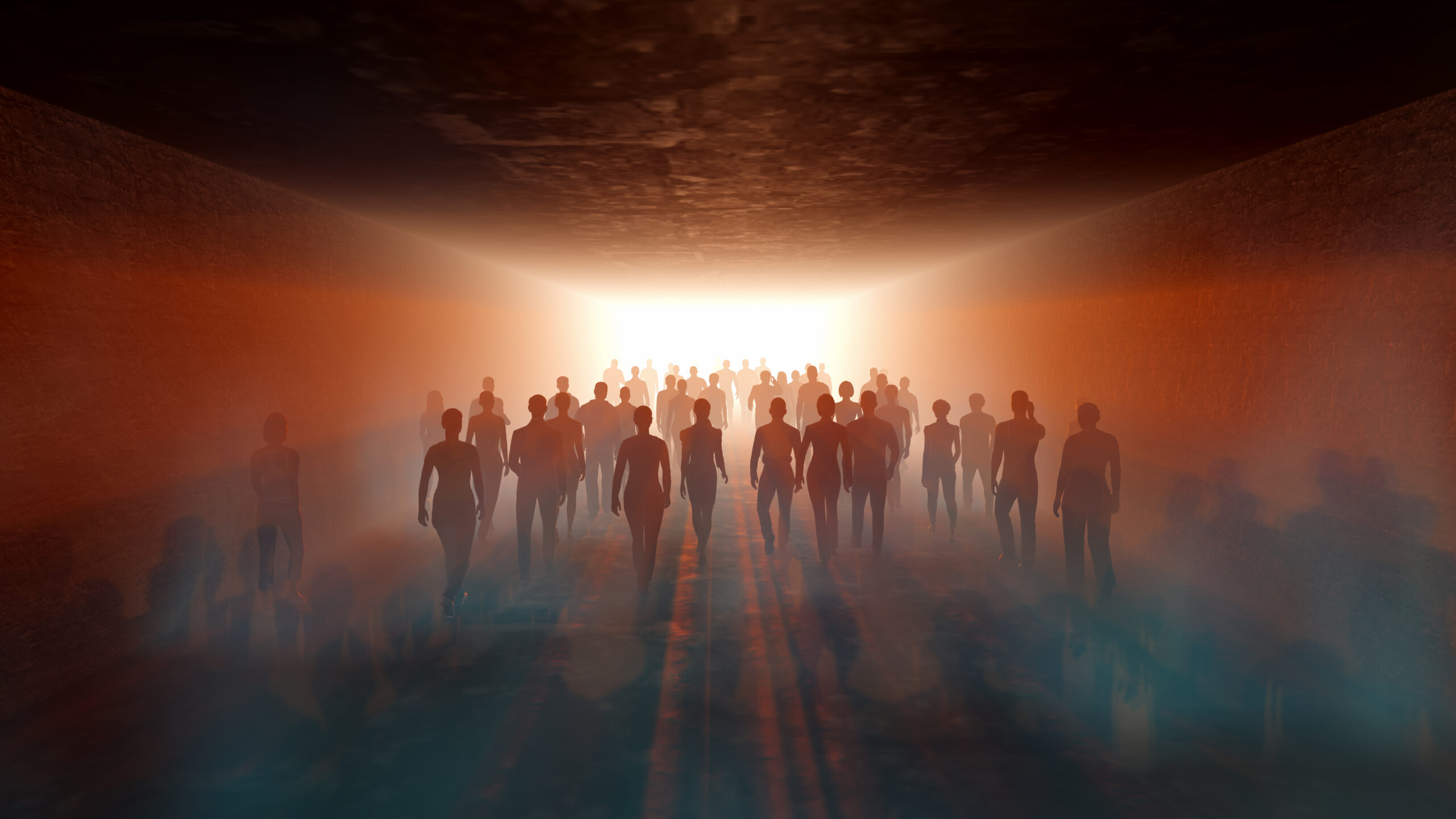Man Who Has Seen Proof That Death Is ‘Not The End’ Explains The Seven ‘Level’ Of Afterlife

What if death isn’t the end, but just the beginning of something far more layered and extraordinary? For centuries, humans have searched for answers—through religion, science, philosophy, and stories passed down through generations. But one modern thinker believes he’s uncovered a structured journey beyond the veil of mortality—one that unfolds across not one, but seven distinct levels of existence.
In The Case for the Afterlife, philosopher and author Chris Carter explores the mysterious claims of Frederic Myers, a 19th-century poet who, according to psychic accounts, began sending messages from beyond the grave. What Myers allegedly revealed offers a radically different—and strangely organized—vision of the afterlife. It’s not about punishment or reward. It’s about progression.
Level 1: Earth – The Beginning of the Soul’s Journey

Most people think of life on Earth as the whole story. Birth, growth, death—the end. But according to Chris Carter’s exploration of Frederic Myers’ posthumous insights, Earth is merely the opening chapter in a much grander tale.
In this framework, Earth is referred to as Level One—not because it’s the most basic, but because it’s the starting point. It’s here, in the messy complexity of human life, that the soul begins its development. Experiences, relationships, emotions, choices—all of it plays a role in shaping the spirit for the journey ahead.
Myers viewed physical life as a training ground—a kind of spiritual boot camp where souls confront challenges, build character, and prepare for what’s next. Death, then, isn’t an ending; it’s more like graduation. A transition. The moment when the soul leaves the classroom and steps into something it may have sensed all along, but never fully understood.
Level 2: Hades – The Astral Rest Stop

If Level One is life on Earth, Level Two is what comes just after we take our final breath—a liminal space known as Hades. But don’t let the name fool you. This isn’t the fire-and-brimstone version etched into religious texts. In Frederic Myers’ account, as explored by Chris Carter, Hades is more like a cosmic layover: quiet, soft, and strangely serene.
Described as the astral plane, Hades serves as a kind of waiting room for the soul—a resting place between the physical world and the deeper spiritual realms. For some, it’s a brief pause. For others, particularly those who die exhausted or emotionally worn out, it offers much-needed peace. Myers himself, who reportedly passed in Italy, described this level as “a place of half-lights and drowsy peace.”
Time in Hades isn’t measured the way we know it. Instead, it’s experienced subjectively. Children or spiritually light souls might pass through in an instant, while others may linger longer, subconsciously shedding the weight of their earthly lives. It’s not a place of judgment, but of gentle transition. A breath between lifetimes. A moment to recalibrate.
Level 3: The Sphere of Terrene Imagination

Now things start to get a little surreal. After the soul’s rest in Hades, it moves into a realm that’s eerily familiar—but dreamlike, more vivid, and profoundly shaped by the inner world of the soul itself. This is Level Three, known as the Sphere of Terrene Imagination. According to Myers’ descriptions, it’s like Earth, but elevated—sharper, richer, and infused with a beauty that transcends anything we know.
Here, reality is no longer governed by physical laws, but by consciousness. Souls create environments drawn from their desires, memories, and moral development. Communities form naturally—clusters of like-minded spirits who build shared spaces of harmony, learning, or artistic expression. For more solitary souls, the surroundings may be entirely self-designed, like a living dream crafted from their deepest longings.
But this level isn’t all celestial gardens and soul families. Not everyone gets the postcard version of paradise. Carter explains that some areas of this plane are dark, empty, even desolate—inhabited by those who led deeply selfish or destructive lives on Earth. There are no punishments here, just consequences—souls trapped in landscapes mirroring the emotional and moral states they carried with them. The good news? They can leave, but only once they’re ready to evolve.
Level 4: Eido – The First True Heaven

For souls that move beyond the imaginative constructs of Level Three, the next stage is something truly otherworldly. Known as Eido, this is what Frederic Myers described as the first real heaven—a realm so breathtaking, so pure, that even the most vivid earthly beauty pales in comparison.
This isn’t a place shaped by the mind, but by something greater—perhaps a universal intelligence, or a collective spiritual harmony. Myers reportedly reached this level himself, and his accounts suggest a landscape of unimaginable color, light, and emotional resonance. Here, everything feels “more real than real.” It’s as if the soul steps into the essence behind all things it once saw as shadow on Earth.
What sets Eido apart is that it’s no longer filtered through personal ego or mental projection. It’s the beginning of a more direct experience of truth, joy, and connection. Souls here begin to shed lingering attachments to their former identities—not through force, but through a natural unfolding. There’s no need to cling to who you were, because who you’re becoming feels infinitely more whole.
It’s often described as the destination people imagine when they speak of “heaven.” But in this model, Eido isn’t the end—it’s only the midpoint of the journey.
Level 5: The Plane of Flame

If Eido is the gateway to the divine, then the Plane of Flame is where the soul begins to burn away everything that remains between it and pure consciousness. But don’t let the name mislead you—this isn’t a place of torment. The “flame” isn’t fire as we know it, but rather a metaphor for intensity, transformation, and spiritual purification.
By this stage, the soul has shed most of its earthly identity and emotional residue. What remains is something closer to essence—an awareness moving toward unity with the source. Myers, communicating from beyond, admitted that words fall short here. The experiences of this realm are so far removed from the physical that they resist human description. What little is known comes in fragments: immense peace, profound clarity, and a feeling of merging into something vast yet intimate.
It’s said that few souls reach this level quickly. It requires deep spiritual development—selflessness, wisdom, and an openness to dissolve the illusion of separateness. Unlike previous planes, which still mirror aspects of earthly life or imagination, the Plane of Flame begins to erase the lines between “self” and “everything else.”
It’s not a place you “arrive at” in the traditional sense. It’s a state you become.
Level 6: The Plane of Light

At this stage, the soul has journeyed so far from the physical world that form itself no longer exists. Welcome to The Plane of Light—a realm where identity dissolves and the soul becomes, quite literally, light.
Frederic Myers described this level not in places or images, but in essence. Here, the soul exists as light, as thought, as a fragment of the Creator’s mind. There is no more “you” in the sense we understand it—no face, no name, no story. Just pure, conscious being. It’s the closest thing to becoming one with the universe without fully vanishing into it.
Souls who reach this plane are said to “join the immortals,” a poetic phrase that suggests unity with beings of immense spiritual evolution. It’s no longer about individual growth or moral lessons—it’s about resonance with the divine frequency itself. Time, as we know it, ceases to have meaning. So does language. All that remains is presence, peace, and radiant knowing.
In Carter’s retelling, this stage is nearly impossible to comprehend from the human perspective—and that’s the point. This isn’t a destination you can visualize. It’s a state of consciousness that must be earned through lifetimes of learning, letting go, and remembering who you truly are.
Level 7: Out-Yonder – Toward the Divine

And then there’s the final frontier: Out-Yonder—the seventh level, where the soul leaves everything behind. Not just the body, not just identity, but even the universe itself.
This is the edge of existence as we know it. According to Myers’ posthumous messages, the soul at this level begins to approach what we might call “God”—but not in the traditional sense. There are no golden thrones, no robed figures offering judgment or salvation. In fact, newly departed souls don’t encounter God at all. The divine, Myers says, exists far beyond the early planes. We’re simply too spiritually primitive, too wrapped in remnants of ego, to come close.
Only here, in Out-Yonder, does the possibility begin.
Carter describes this level as not a place, but a passage. A sacred unfolding, where the soul moves beyond form, memory, and even light. It is the soul’s flight from the physical universe—a rejoining with the source that set it in motion. And even then, the journey may not be over. Because this level isn’t about arrival. It’s about union.
If earlier stages resembled a climb, this is a letting go. A surrender so complete that what remains is no longer a traveler, but the path itself.
What This Means: A New Vision of Life After Death
If you’ve made it this far through the seven levels, one thing becomes clear—this isn’t your Sunday school version of the afterlife. There are no pearly gates or fiery pits, no eternal verdict handed down based on a single life’s mistakes or merits. Instead, what emerges from Carter and Myers’ accounts is something far more intricate—and in many ways, more compassionate.
This view of the afterlife isn’t built around reward and punishment, but around evolution. Each level is a mirror, revealing the soul’s readiness to release old identities and grow into something freer, lighter, and more unified with the divine. The journey isn’t about escaping judgment; it’s about outgrowing limitation.
And that reframes life itself.
It suggests that what we do here—our choices, our values, our ability to grow—matters not because of fear, but because of potential. Earth becomes more than a proving ground; it’s a beginning. A training space for empathy, resilience, and self-awareness that echoes far beyond the physical body.
Whether you take these ideas as literal truths or symbolic insights, they offer a powerful lens through which to view both life and death. Not as opposites, but as points along a much longer journey—one that’s always inviting us to take the next step forward.
A Journey That Continues

At its core, this seven-level model of the afterlife isn’t just a map of what might come after death—it’s a reflection of how we live, grow, and evolve in the here and now. Chris Carter’s exploration of Frederic Myers’ alleged communications offers a version of the afterlife that feels more like a spiritual progression than a final judgment. It’s less about where you go, and more about who you become.
Whether or not you believe in messages from beyond or the possibility of conscious existence after death, the framework invites us to think differently about what it means to live a meaningful life. Growth, kindness, curiosity, and self-reflection—these aren’t just spiritual goals, they’re fuel for the soul’s journey through every level, seen or unseen.
In the end, perhaps the most important takeaway isn’t about where we go after death, but how fully we show up while we’re here.
Featured Image Source: Shutterstock
Loading...

